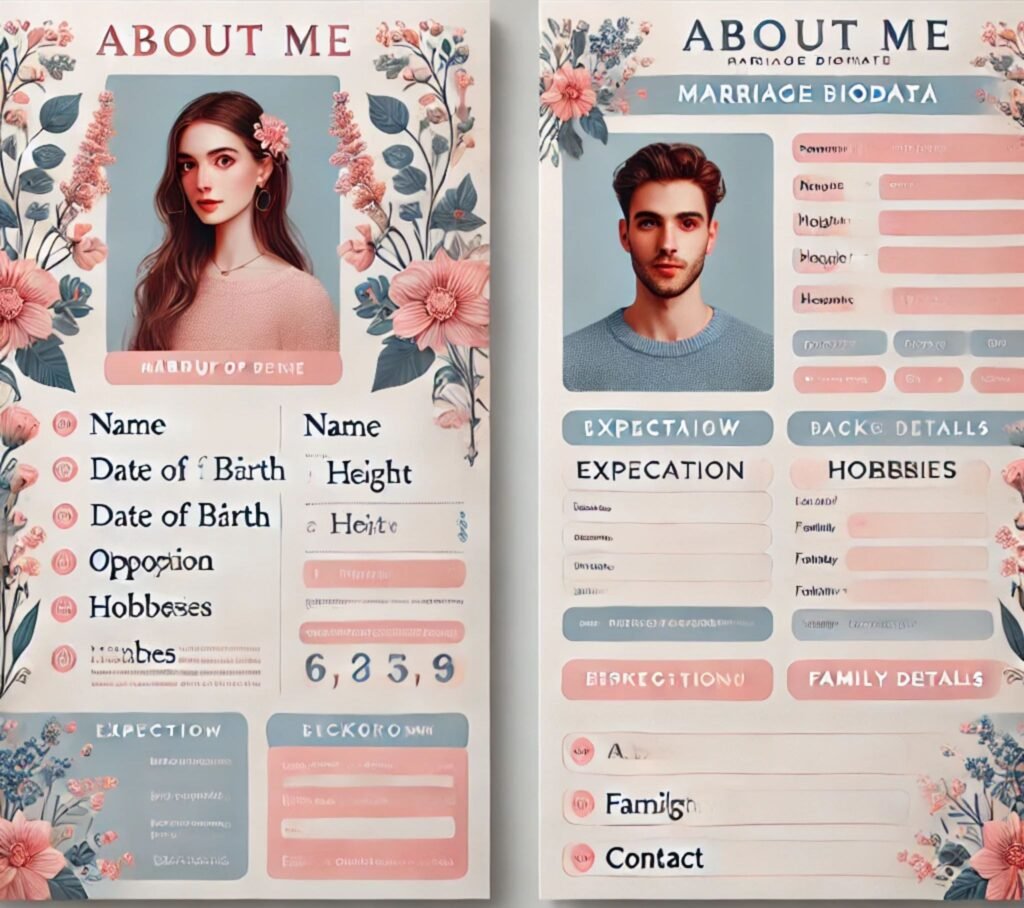Creating a simple biodata for marriage seems like a straightforward task. After all, you’re just listing facts about yourself—right? But in reality, your biodata is the first impression you make on a potential match and their family. A well-crafted biodata can open doors, while a poorly made one can shut them before you even meet. Many people unknowingly make common errors that cost them serious proposals or delay the matchmaking process.
In this article, we’ll walk through the top mistakes people make when creating a simple biodata for marriage—and how you can avoid them. Whether you’re preparing your first biodata or refining an existing one, these tips will help ensure that your profile stands out for the right reasons.
Missing or Incomplete Personal Information
One of the most common mistakes is skipping essential personal details. This includes your full name, age, date of birth, height, weight, religion, caste/community, and mother tongue. Failing to include these clearly can create confusion or make your profile seem suspicious.
Tip: Double-check that all personal identifiers are filled in and up to date. Always mention information clearly and in standard formats. For example, write your height in feet/inches or cm, and avoid vague entries like “average height.”
Using Overly Complicated Language or Design
Remember, the goal is to make your biodata easy to read and understand. Over-designing it with fancy fonts, borders, or cluttered sections often works against you. While it may seem “modern,” it can come across as unprofessional or distracting.
Tip: Use a clean and simple layout with clearly marked sections. A simple biodata for marriage should be functional, not flashy. Prioritize clarity over style.
Too Much or Too Little Education/Job Detail
Some candidates list every award, internship, or part-time job they’ve ever had, turning the biodata into a résumé. Others just say “Engineer” or “Teacher” with no further context. Neither approach helps.
Tip: Include your highest education qualification, current job title, employer name, and job location. A line or two about your role or industry adds value but avoid writing full job descriptions. Brevity + clarity = impact.
Skipping Family Background Information
Many people forget or choose to leave out their family background, assuming it’s unnecessary. But in traditional Indian matchmaking, the family’s background is as important as the individual’s.
Tip: Include basic family information such as father’s occupation, mother’s occupation, number of siblings, and their professions or marital status. This adds context to your marriage biodata details and gives families a sense of compatibility.
Lack of Honesty or Inflated Claims
It’s tempting to stretch the truth to look more appealing—like tweaking your age, salary, or academic records. But such misrepresentations usually get caught during the matchmaking process and lead to broken trust.
Tip: Honesty is essential. Highlight your strengths but don’t hide your weaknesses. A good match is based on truth, not illusion.
Overlooking Cultural and Regional Relevance
What works in one community may not work in another. For instance, a shadi biodata format for a South Indian alliance may differ from a Sikh or Marwari one in tone and structure.
Tip: Use templates that match your region, language, and community’s expectations. You can still keep it simple, but be mindful of what the receiving family is looking for in terms of format and information flow.
Poor Grammar, Typos, or Spelling Errors
Even if your profile is strong, basic grammatical mistakes or spelling errors can ruin your impression. It shows carelessness and lack of attention to detail.
Tip: Proofread carefully. Use online grammar tools or have a friend or family member review your biodata. A single misplaced word can change the meaning or professionalism of the document.
Including Irrelevant or Sensitive Information
Some people get too personal or emotional in their biodata, sharing past relationship experiences, health history, or political views. Others include hobbies like “partying” or “watching TV,” which don’t leave a lasting impression.
Tip: Stick to relevant topics: career, education, family, interests, and expectations. Share values that align with marriage—not personal confessions.
Not Mentioning Partner Preferences Clearly
Many biodatas skip a “Looking For” or “Partner Expectations” section altogether. This causes ambiguity and wastes time if there are mismatches down the road.
Tip: Briefly mention your preferences in terms of age range, education, location, or career, if you have any. Avoid sounding rigid or demanding. Keep it open yet informative.
Neglecting the Online Version
In today’s digital age, many matches happen via matrimonial sites or social media. If your marriage bio data online version is poorly formatted or has outdated photos, it can affect your chances.
Tip: Make sure the online version of your biodata is mobile-friendly, properly formatted, and includes a recent photo. A professional or semi-casual photo is better than heavily filtered or passport-style ones.
Copy-Pasting from Generic Templates
Using a ready-made template is fine, but blindly copying generic content like “I am a sincere and honest person” makes your biodata boring and impersonal.
Tip: Personalize your profile. Write a short paragraph in your own voice that reflects who you are. This makes your shadi biodata stand out and helps families connect better with your personality.
Sharing Incomplete Contact Information
Often, people hesitate to share contact details like phone numbers or emails, thinking they’ll be misused. While caution is valid, completely omitting contact details leads to missed opportunities.
Tip: Use a dedicated matrimonial phone number or email ID. Share it once trust is established or via the platform’s messaging system if using marriage bio data online platforms.
Forgetting to Update the Biodata Regularly
Life changes—new job, higher salary, relocation. Many people forget to update their biodata, leading to confusion or mismatched expectations during the proposal process.
Tip: Revisit and revise your biodata every few months. This ensures all information, especially in your marriage biodata, stays current and relevant.
Not Including a Recent Photograph
Photographs are important for initial interest, especially in arranged setups. Yet many people either skip it or use outdated, low-quality images.
Tip: Attach a well-lit, recent photo in traditional or semi-formal attire. Make sure the photo aligns with your personality and is appropriate for a matrimonial context.
Conclusion
A marriage biodata is more than a document—it’s a first step toward a lifelong partnership. By avoiding these common mistakes, you not only present yourself well but also improve your chances of finding a compatible match. Whether you’re creating your bio data for marriage simple or a more detailed version, remember that clarity, honesty, and personalization are your best tools.
Treat your biodata like a reflection of who you are—not just on paper, but in life. When done right, it can open the door to a beautiful new beginning.







